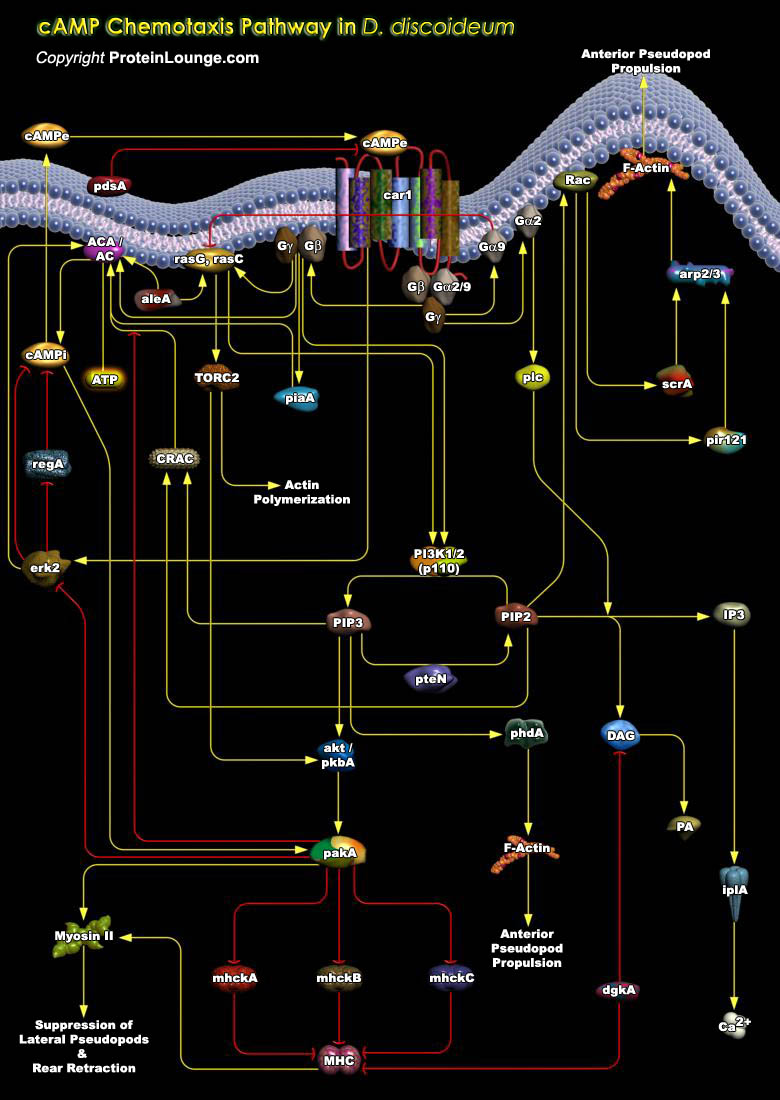
Dictyostelia are a group of organisms that generally aggregate to become multicellular. There are approximately 120 known species of Dictyostelium. Dictyostelium discoideum belonging to the group 4, secrete cyclic adenosine monophosphate (cAMP) toact as a chemo attractant for aggregation. Dictyostelium is a simple eukaryotic model for the study of chemotaxis. Advantages of D. discoideum as a model organism include its genetic, biochemical and cell biological accessibility (Ref.1). The social amoebae D. discoideum has proven indispensable to elucidate signaling events that regulate Chemotaxis. In D. discoideum, cAMP (Cyclic Adenosine 3'-5'-Monophosphate), Folic Acid as well as factors from Bacteria, serve as Chemoattractants. In Dictyostelium, chemotaxis is[..]
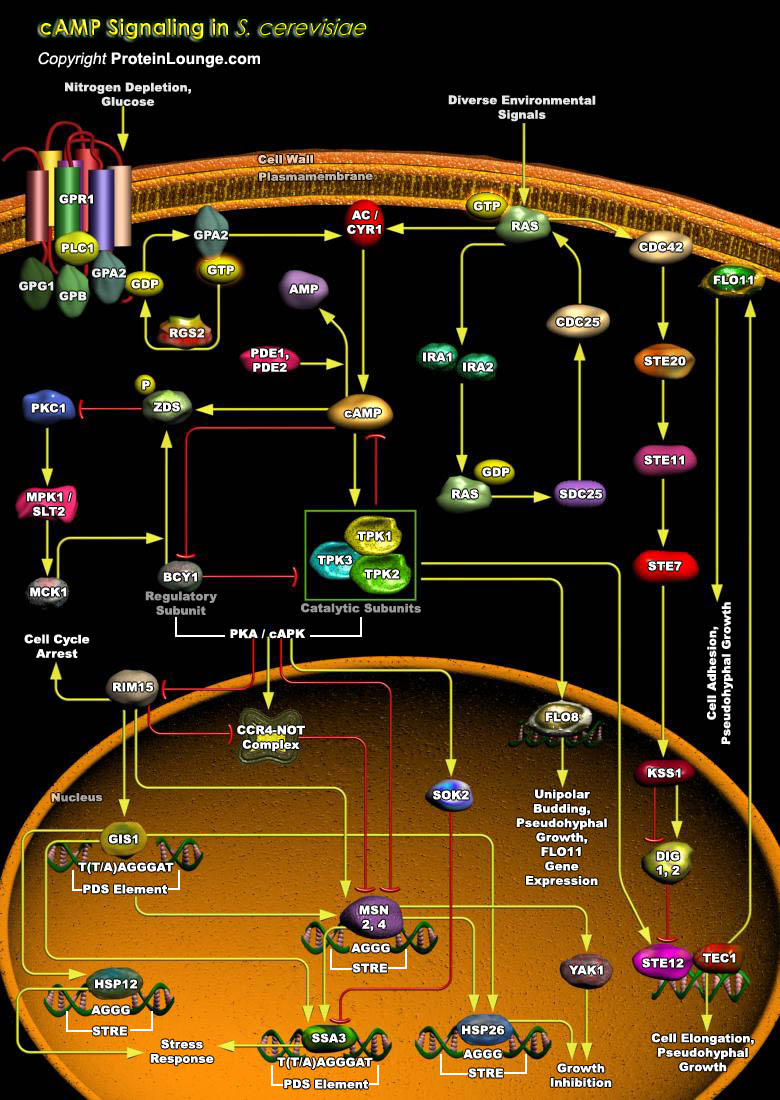
Nutrient derived signals are generally sensed by all organisms in order to adapt themselves to the environment and promote survival. In the budding yeast Saccharomyces cerevisiae (S.cerevisiae), extracellular glucose and a plethora of signals regulate the production of intracellular cAMP. cAMP and associated pathway is important in growth regulation, cell metabolism, virulence, morphogenesis and stress resistance (Ref.1 and 2). cAMP, the central messenger of the pathway is synthesized from ATP by the action of adenylae cyclase encoded by the CYR1/CDC35 gene and the cyclase-associated protein (CAP) encoded by the SRV2 gene (Ref.3).G-protein receptor GPR1 and associated G-alpha subunit GPA2 regulate the activity of adenylate cyclase and cAMP. A small G protein RAS also[..]
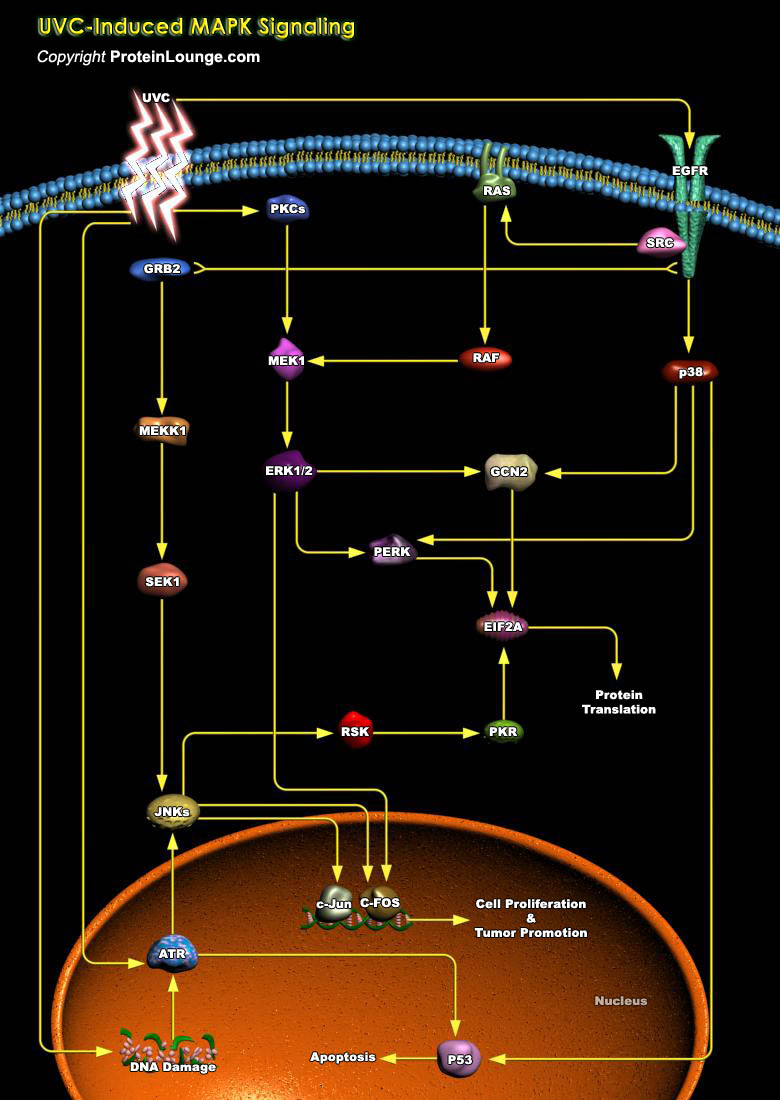
Ultraviolet radiation (UVR) is an electromagnetic radiation that is shorter in wavelength than visible light but longer than X-rays. It falls in the range of 100nm to 400nm and is the most important environmental carcinogen leading to the development of skin cancers. UVR is divided into at least three different categories based on wavelength that includes ultraviolet C (UVC; 100–280 nm), ultraviolet B (UVB; 280–320 nm) and ultraviolet A (UVA; 320–400nm). The energy level of UV light is inversely related to its wavelength with UVC possessing higher levels than that of UVB (Ref.1). The MAPK (Mitogen-Activated Protein Kinase) signaling cascades are targets for UV and are important in the regulation of the multitude of UV-induced cellular[..]
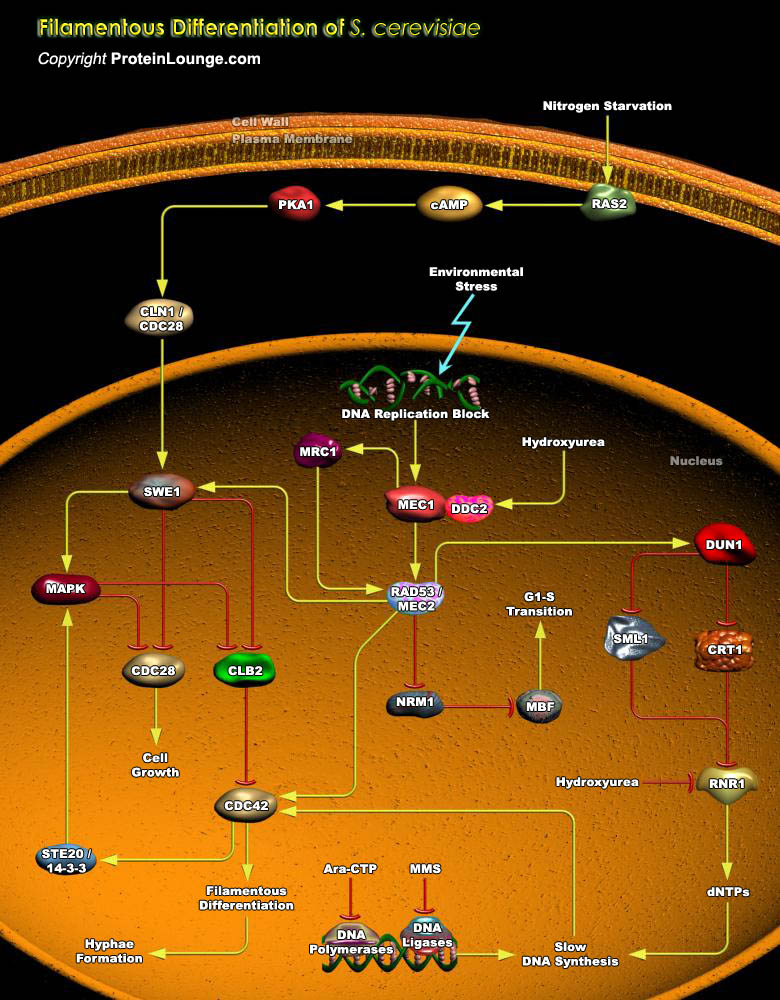
Unicellular S.cerevisiae (Saccharomyces cerevisiae) undergoes developmental switches between two differentiation states in response to environmental cues. Under stress conditions, diploid S.cerevisiae cells switch from the yeast form (growth as single oval cells) to the filamentous or pseudohyphae form (growth as elongated cell chains that retain physical attachment between the mother and daughter cells). Filamentous differentiation of S.cerevisiae is a potential model system for study of eukaryotic differentiation. Slowed DNA synthesis induces filamentous differentiation in yeast and it involves the conserved cell cycle regulators Swe1 (Mitosis Inhibitor Protein Kinase-Swe1), CLB2 and CDC28 (Cell Division Control Protein-28) (Ref.1). DNA integrity checkpoints are[..]
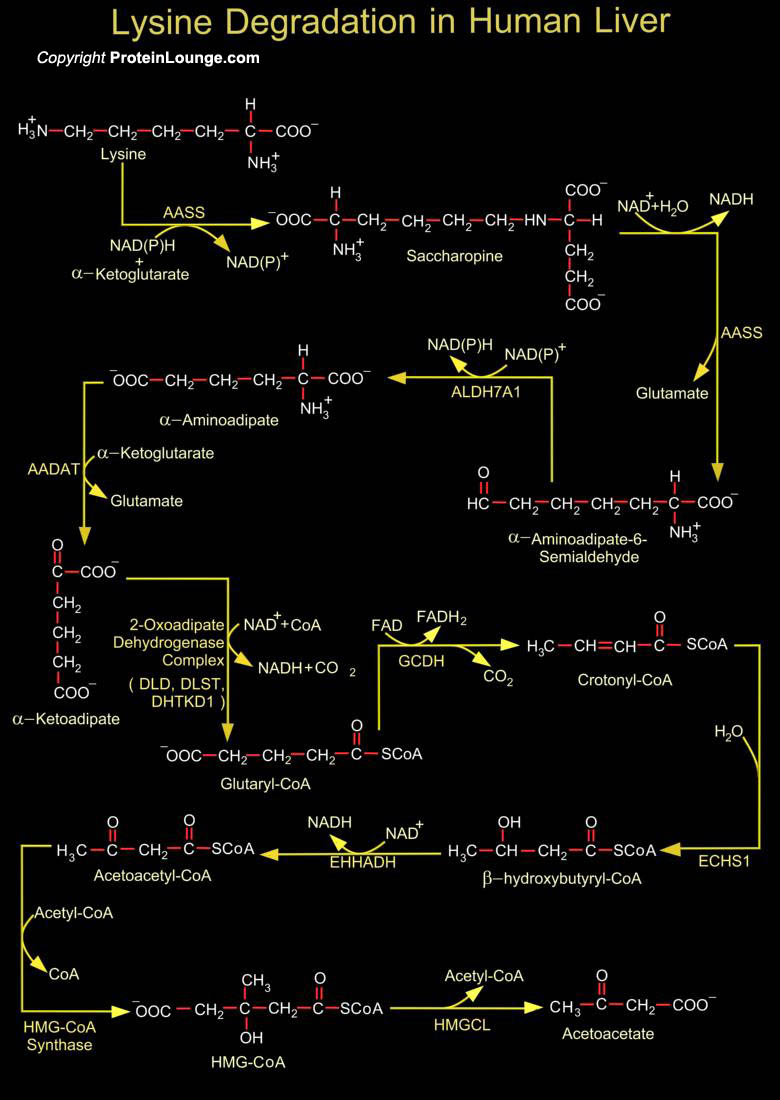
In humans, Lysine is an essential amino acid, and there is no Lysine biosynthetic machinery. However, humans do degrade Lysine. Lysine is incorporated to Collagen, one of the most important components of Connective tissue and its supply is therefore required during embryonic development and early childhood (Ref.1). It is also important for Carnitine Synthesis. The main catabolic pathway for Lysine, via Saccharopine (e-N-(L-Glutaryl-2)-L-lysine), is a mitochondrial pathway leading to the formation of Acetyl-CoA (Acetyl-Coenzyme-A). Another Lysine degradation mechanism that is the Peroxisomal Pathway, via Pipecolic Acid is of less physiological importance and is mainly active in brain. The existence of two minor pathways for Lysine degradation, the Acetyl-lysine[..]
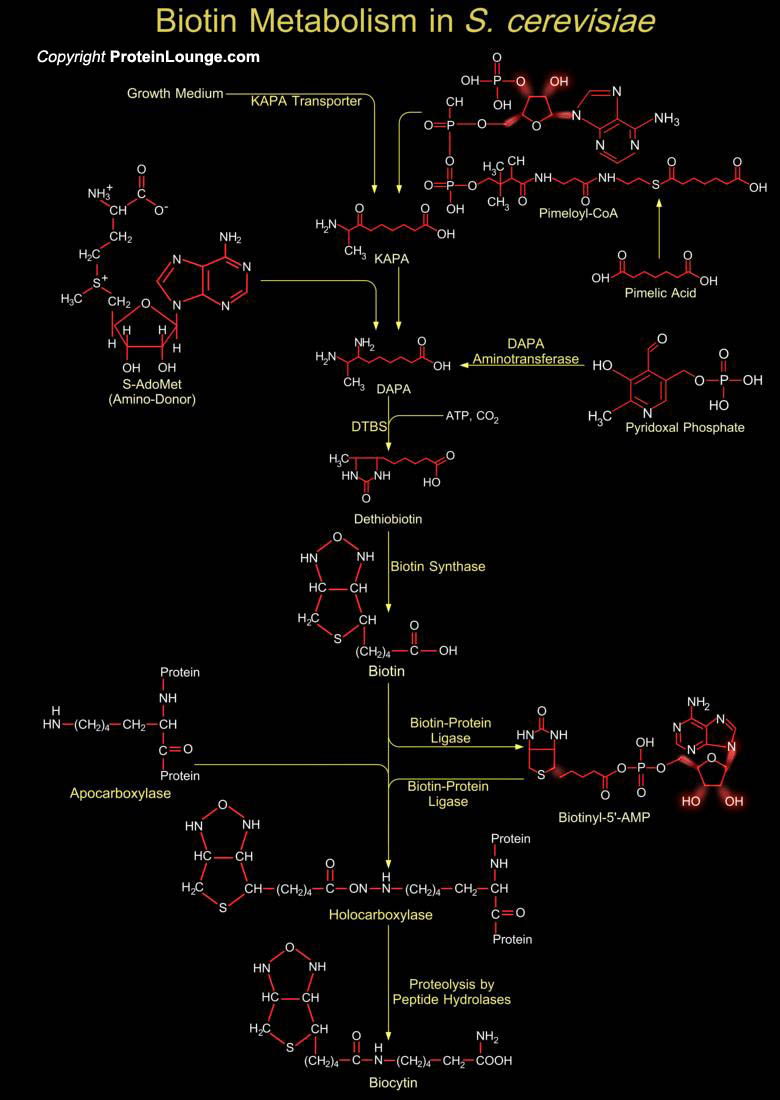
In unicellular eukaryotes like S. cerevisiae (Saccharomyces cerevisiae), Biotin or Vitamin-H, a member of B-Complex group of Vitamins acts as a cofactor for a few essential enzymes of the Carboxylase family. It is also required for the biosynthesis of fatty acids and the metabolism of amino acids and carbohydrates. Some organisms, including higher plants and most fungi and bacteria, are prototrophic for Biotin. Others, including most vertebrates and some bacteria, rely on exogenous sources (Ref.1 & 2). In mammals, Biotin is supplied by intestinal bacteria. Biotin is a colorless Vitamin and Orthorhombic when crystallized. It consists of two fused rings: an Imidazol (Ureido) and a Sulfur-containing (Tetrahydrothiophene) ring; and the latter is extended via[..]
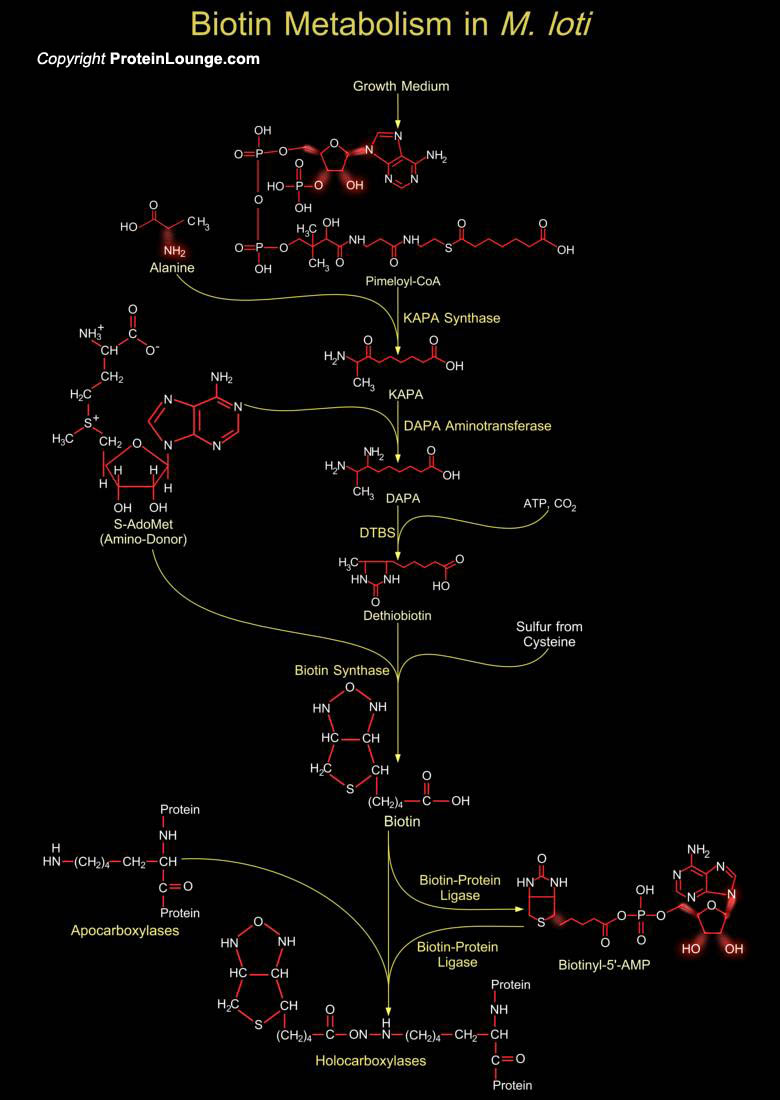
Symbiotic bacteria, together with Phytopathogenic microbes, are plant-interacting microorganisms of major agronomic importance. Among these, Rhizobia are root-nodule-forming Nitrogen-Fixing Legume Symbionts. These microorganisms, in addition to providing an ideal model for studying plant-microbe interactions, play an important role in global nutrient cycling. In Rhizobium sp. also known as Mesorhizobium sp., the majority of the symbiosis genes are contained on a 500 kb (500 Kilobase) chromosomal genetic element termed a Symbiosis Island (Strain R7A). Phenotypic characterization of the Non-Symbionts present in the environment, reveals that they are initially auxotrophic for Biotin (or Vitamin-H) and Thiamin (Vitamin-B1) (Ref.1). Transfer of the Symbiosis Island from[..]
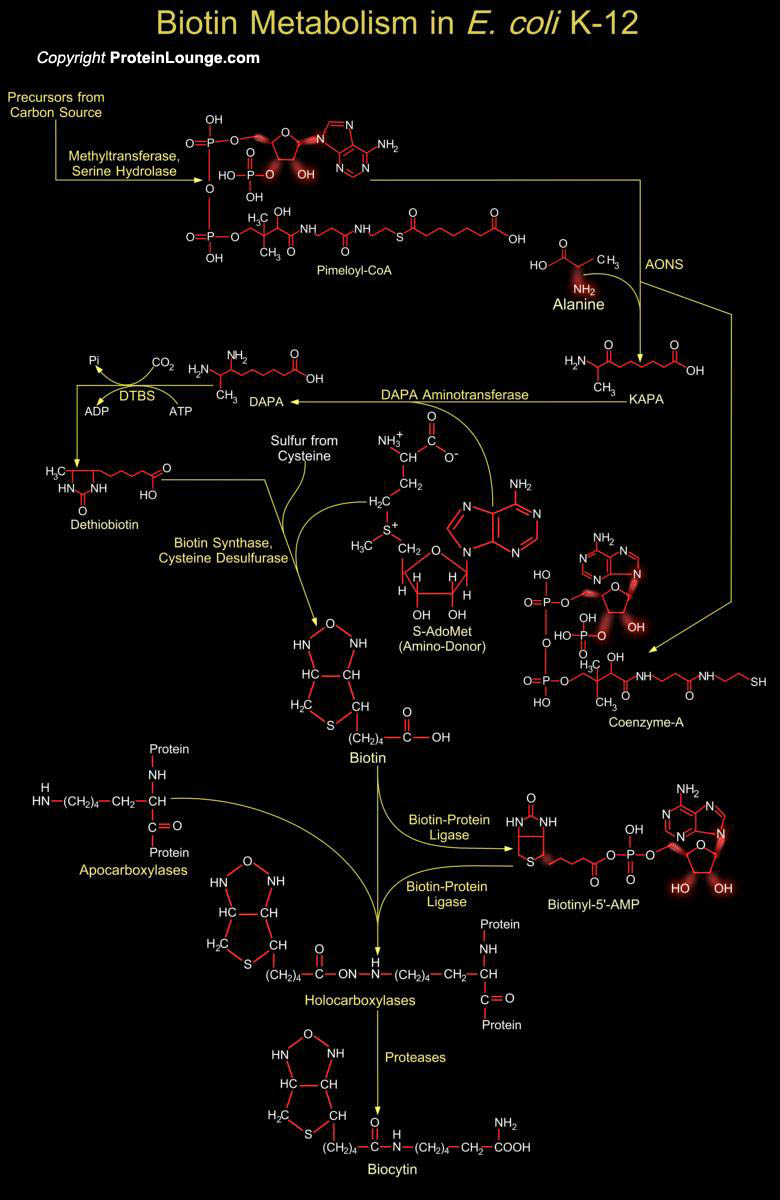
One of the most fascinating cofactors involved in central pathways of pro- and eukaryotic cell metabolism belongs to the B-Complex group of Vitamins known as Biotin or Vitamin-H. Biotin is a colorless and orthorhombic, consisting of two fused rings: an Imidazol (Ureido) and a Sulfur-containing (Tetrahydrothiophene) ring; and the latter is extended via a Valeric acid side chain, which is attached in a cis-configuration with respect to the Ureido ring. Both rings are fused in cis. Biotin contains three chiral carbon atoms, resulting in eight possible Stereoisomers. However, only the Biotin possesses Vitamin activity. The correct chemical name for the cofactor is: Hexahydro-2-Oxo-1H-Thieno (3,4-D) Imidazole-4-Pentanoic Acid. It is noteworthy that this Vitamin withstands[..]
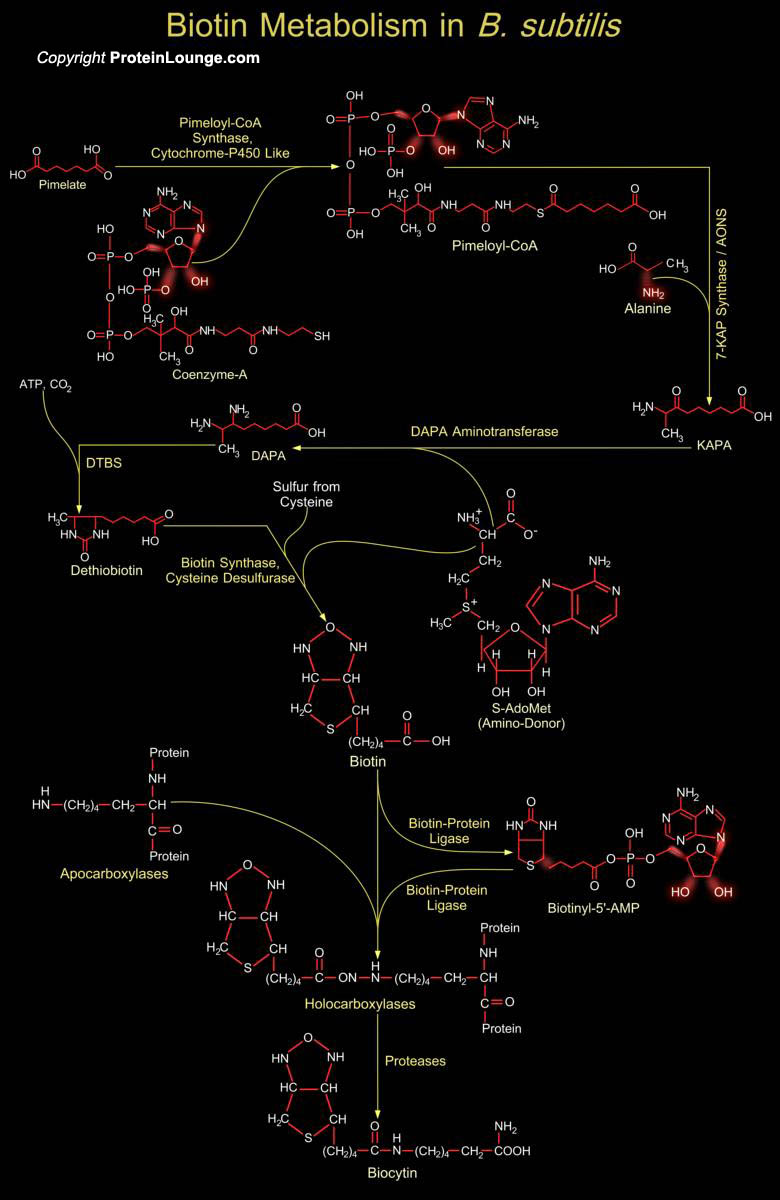
The colorless and orthorhombic Vitamin, Biotin or Vitamin-H, is essential for all living organisms and acts as a cofactor for a few essential enzymes of the Carboxylase family. Bacteria, most fungi and higher plants, are prototrophic for Biotin. Most vertebrates and even some bacteria, rely on exogenous sources. In mammals, Biotin is supplied by intestinal bacteria. In general, Biotin consists of two fused rings: an Imidazol (Ureido) and a Sulfur-containing (Tetrahydrothiophene) ring; and the latter being extended via a Valeric acid side chain, which is attached in a cis-configuration with respect to the Ureido ring. Both rings are fused in cis. Biotin contains three chiral carbon atoms, resulting in eight possible Stereoisomers (Ref.1). The Biotin only possesses[..]
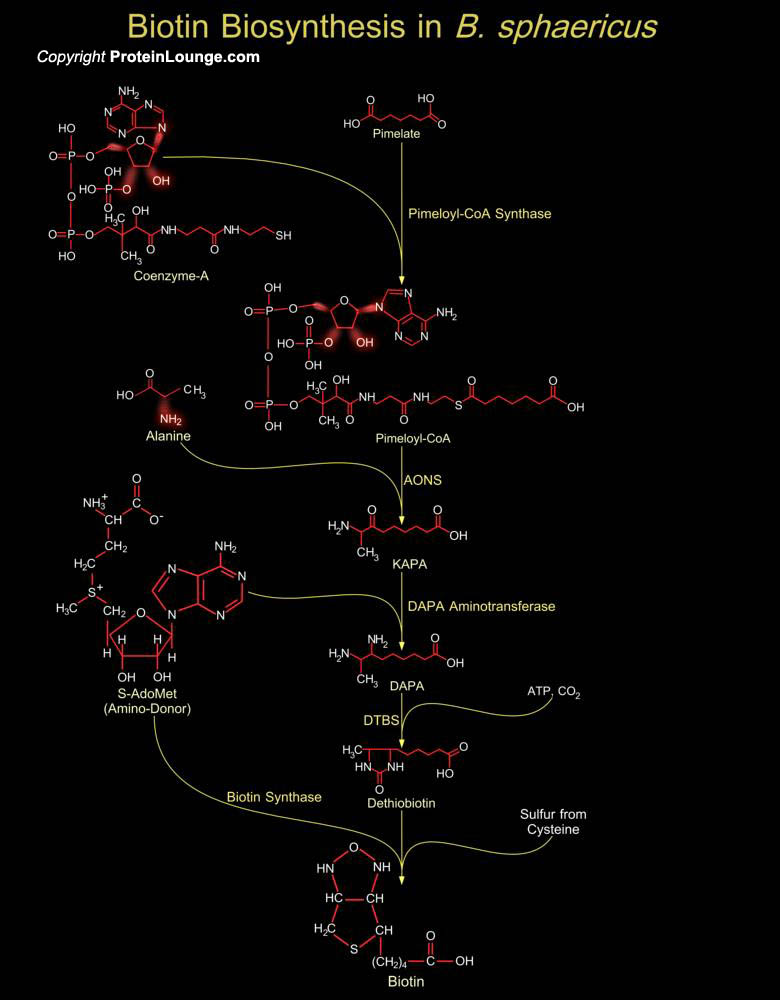
Biotin (Vitamin-H) is essential for all living organisms and acts as a cofactor for a few essential enzymes of the Carboxylase family. Higher plants, most fungi and bacteria, are prototrophic for Biotin. Others, including most vertebrates and some bacteria, rely on exogenous sources. In mammals, Biotin is supplied by intestinal bacteria. Biotin is a colorless Vitamin and Orthorhombic when crystallized. It consists of two fused rings: an Imidazol (Ureido) and a Sulfur-containing (Tetrahydrothiophene) ring; and the latter is extended via a Valeric acid side chain, which is attached in a cis-configuration with respect to the Ureido ring. Both rings are fused in cis. Biotin contains three chiral carbon atoms, resulting in eight possible Stereoisomers (Ref.1). The Biotin[..]
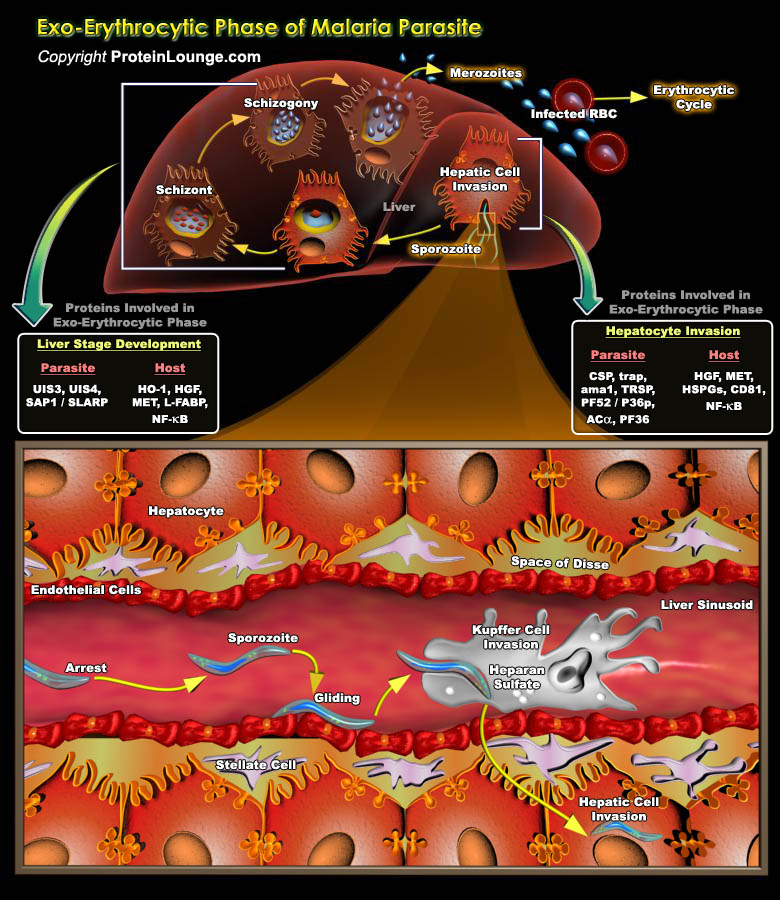
Malaria (from the Italian mal'aria, meaning bad air) is an Acute infection caused by four species of the Protozoa genus Plasmodium: P.falciprium, P.vivax, P.malariae and P.ovale. Plasmodium falciparum is the main cause of disease and death from Malaria. The parasite is transmitted to Humans through the bite of the infected female Anopheles Mosquito. Life cycle of Plasmodium inside Human body can be broadly classified into 2 phases: Pre/ Exo-Erythrocytic phase, and Erythrocytic phase. Exo-Erythrocytic cycle begins when the carrier Female Anopheles mosquito takes a blood meal. Mosquito injects Sporozoites into Human body during the blood meal. Sporozoites travel to the liver to initiate the infection (Ref.1). The entry of Sporozoites to Hepatocytes is mediated[..]
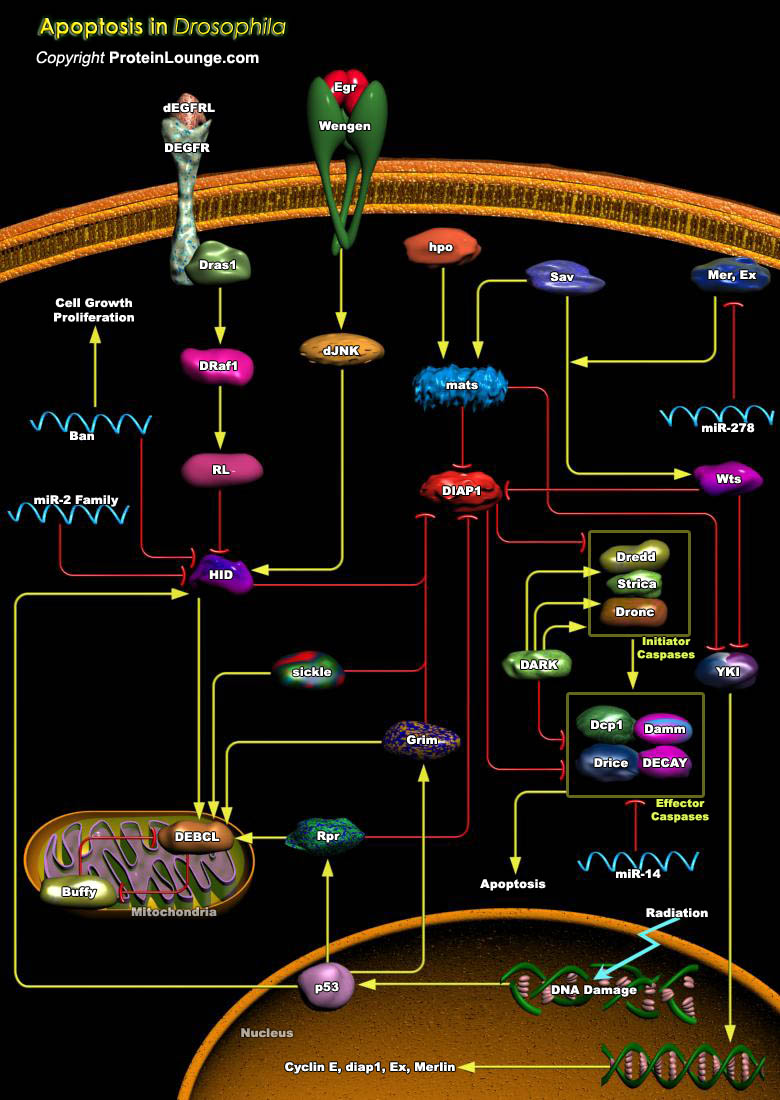
Apoptosis refers to an evolutionarily conserved method of Cell Death that is characterized by specific morphological and biochemical properties. Morphologically, Apoptosis is characterized by a series of structural changes in dying cells: Blebbing of the plasma membrane, Condensation of the cytoplasm and nucleus, and Cellular Fragmentation into membrane Apoptotic bodies. Biochemically, Apoptosis is characterized by the degradation of Chromatin, initially into large fragments of 50-300 kilobases and subsequently into smaller fragments that are monomers and multimers of 200 bases. Programmed Cell Death by Apoptosis is a common way for deleting unwanted and superfluous cells. It is crucial during development as well as in the maintenance of tissue homeostasis and[..]

